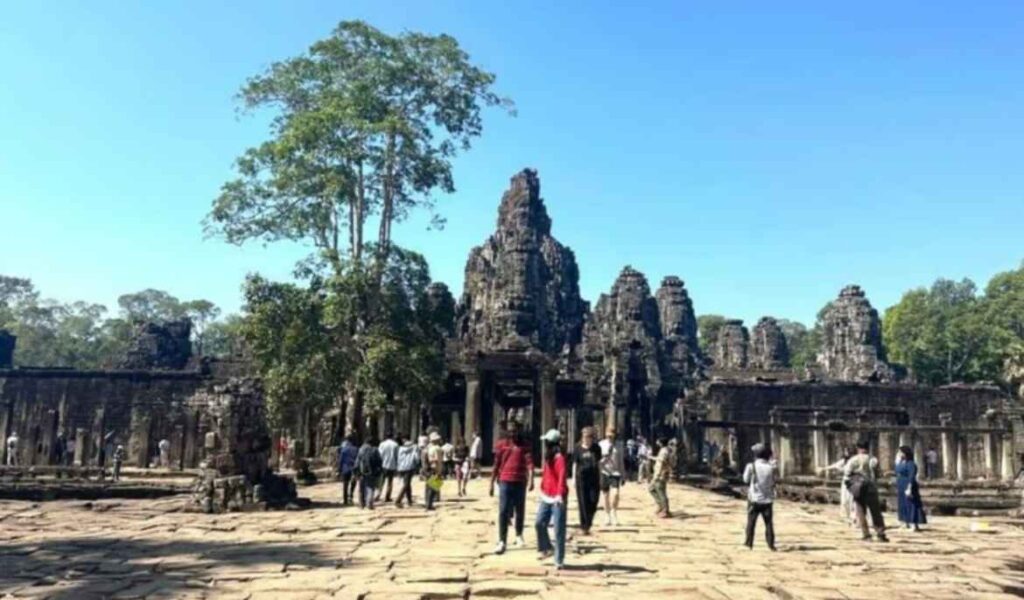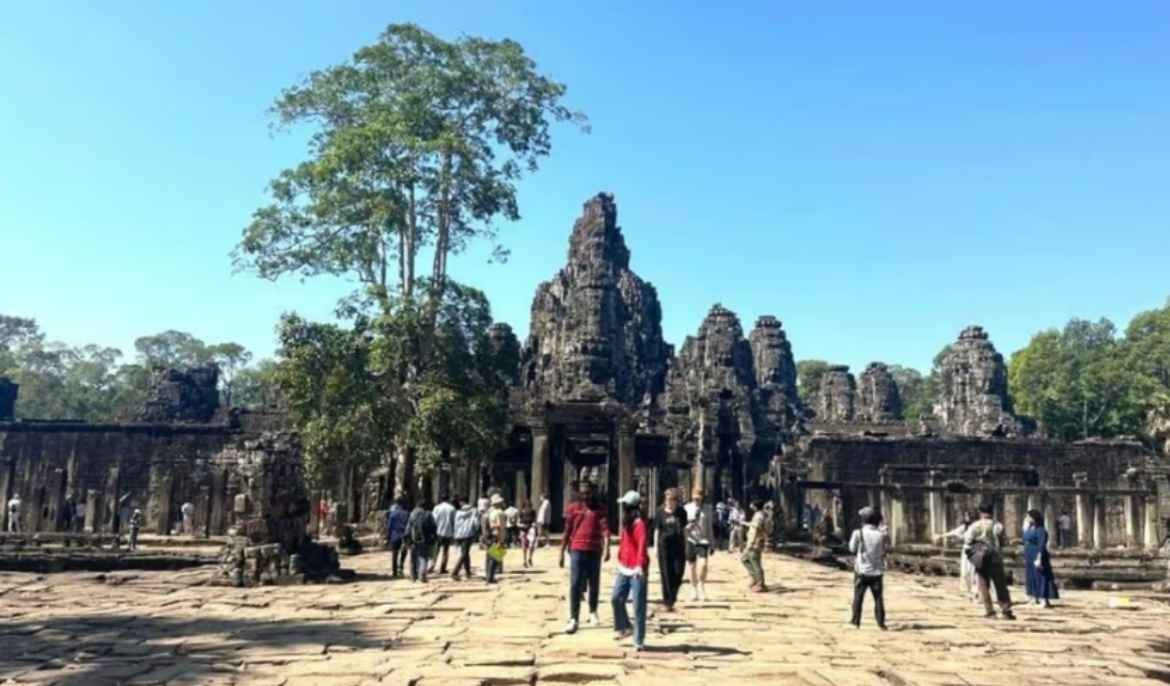If the life of law is not logic but experience as Holmes said, the legal fraternity must go around the globe to learn more about cross-border cultural life and natural history, writes Mohan Katarki.
A visit to Cambodia during the Christmas holidays by the team of lawyers under the aegis of the Bar Association of India— hosted by the Cambodia Bar Association— was a refreshing break for the litigating warriors.
Even though traveling was definitely for tourism, it has its way of enhancing knowledge of law through interdisciplinary exploration, especially looking at the cultural history of a nation that connects with our own country.
We explored the impact of the Indic philosophy on the Khmer dynasty, the history of the constitutionalisation of Cambodia, and the relevance of the Mekong to international water conflicts which are erupting more due to the threat of climate change.
Indic philosophy invaded Cambodia
Cambodia’s tryst with Indic philosophy has been attracting huge interest, particularly due to the architectural beauty of temples, though these temples are not places of worship anymore.
Indic philosophy of life and religion traveled to East Asia in the Middle Ages with trading traders from South India. The then Khmer dynasty of Cambodia embraced the Brahminical religion, now popularly known as Hinduism and endeared to Indic philosophy by promoting its art and culture.
The dynasty apparently sought to justify its legitimacy by relying on a religious theory that the king is an avatar of Vishnu; one of three avatars of Ishwar in theistic Indic philosophy.
On embracing Hinduism, the Khmer regime in Cambodia developed places of worship with great passion from the ninth century onwards. The Siem Province— a seat of Khmer rulers— became the place for magnificent temples.
The Angkor Wat temple, though one of the many temples in Cambodia, stands out. It is probably the biggest temple of the Hindu religion in the world. Reportedly, more stones have been used to build the temple than were used in the construction of the pyramids in Egypt.
The tour guide told us that tourists— particularly European tourists— take three full days to explore the architectural finesse of this temple devoted to Vishnu. The guide sounded true because the entry ticket pass lasts three days! No wonder why this temple is UNESCO’s World Heritage Site.
However, the trust in the theistic Indic philosophy, which boomed with the Khmer regime in the ninth century, gradually changed to non-theistic Indic philosophy after the 13th century. The Khmer dynasty changed its affiliation to Buddhism— a non-theistic religion of Indic philosophy.
The reasons for the change of faith are not clear. Did theistic Hinduism fail to catch up with the common man leading to its abandonment by the Khmer regime? There is no credible study in that regard. Probably, there are no contemporaneous records available. If conjectural theorisation of history is permissible in such a situation, Hinduism remained the religion of only the royals because they thought it would legitimise their power as Kshatriyas.
Even though traveling was definitely for tourism, it has its way of enhancing knowledge of law through interdisciplinary exploration, especially looking at the cultural history of a nation that connects with our own country.
The masses were not absorbed within the grandeur of Hinduism in Brahminical settings. At this hour, Buddhism— a non-theistic school under the Indic philosophy— probably gained acceptance among the masses. This seems to have forced Khmer royals eventually to cross over to Buddhism.
However, despite the change, the belief in the triumvirate: Vishnu, Shiva and Brahma as avatars of Ishwar or God as ultimate reality did not end. Even though Therwada Buddhism challenges the Brahminical order— a cultural mix of Hinduism and Buddhism in Cambodia is quite apparent even now.
After the decline of the Khmer regime and the rise of non-theistic Buddhism in the 17th century, the magnificent Hindu temples, including the great Angkor Wat temple, lost out apparently. Surprisingly, the causes for the neglect of these temples remain unexplored by historians so far.
The forgotten and lost temples in the forest first fell to the notice of Portuguese traders. In 1860, the Angkor Wat temple was reportedly rediscovered by Frenchman Henri Mouhot with the help of missionary Charles-Émile Bouillevaux.
The temple restoration started under colonial French power. This masterpiece temple has been receiving 2.5 million visitors annually— a mix of Indians and Europeans. Why not? The temple truly symbolises the outreach of Indic philosophy in East Asia.
Mekong fertilises Cambodia
The Mekong International Basin has been a lifeline to the Indo-China countries of Laos, Thailand, Cambodia and Vietnam. The basin has also acquired importance in China, where the river rises in the Tibetan part of the Himalayas.
Generally, the Brahmaputra, Ganges and Indus basins are drained by the melting snow from the southern slopes of the Himalayan ranges, and the northern part of the mountains drains the Mekong River.
Needless to mention the Himalayas are one of the most glacierised regions in the world after the polar areas. The Himalayas are truly becoming known as the water tower of the world.
The tension between China as an upstream State and Indo-China countries as a group of downstream States has been a matter of discussion on geopolitical concerns that it raises and the needs of millions of farmers. Even though China contributes less than 20 percent of the basin’s water, its supplies during summer months from the melting snow are crucial for summer rice crops and flora and fauna in the basin.
The Mekong International Basin has been a lifeline to the Indo-China countries of Laos, Thailand, Cambodia and Vietnam.
Is China trying to weaponize the Mekong by building dams on the Mekong? There is no easy answer to this. China has reportedly built 13 hydropower dams on the main Mekong River.
Even though hydropower generation is considered non-consumptive since water flows down, the dams can be abused and weaponised by diverting the storage across the basin to trans-basin areas and sometimes, by flooding the downstream. Hopefully, no responsible country would do such an act against the lives and properties of millions downstream.
Mekong water sustains irrigation and fish culture in Cambodia. Rice and fish are part of the staple food of Cambodians. Even economically, the rice exports earn forex for Cambodia. The visual sight of lush green land while traveling by road from Phnom Penh to Siem Reap was a treat to watch. Even historically, Cambodians are credited for developing excellent drainage networks.
The customary rules of international water law on the sharing of water resources have been developed to guide the States in developing water resources without exceeding equitable share and without causing injury to historical interests.
The UN General Assembly and international law association have codified the rules. However, the application of the rules on the ground needs extensive analysis by techno-legal experts.
The downstream States of Laos, Thailand, Cambodia and Vietnam forming part of the Indo-China region entered into an international agreement in 1995, establishing the Mekong River Commission to utilise water in a coordinated manner.
The Mekong River Commission has been cited as a precedent in promoting participatory governance of international or transboundary rivers. However, upstream China is not part of the deal. Even then, China has shown cooperation by cooperating from 2002 onwards with the Mekong River Commission by supplying daily data and information on flows, etc. Hopefully, Mekong continues to flow without disturbing peace and prosperity.
Legal tourism is not unknown. But. It usually involves visits to study and understand legal developments.
Cross-border legal tourism
Legal tourism is not unknown. But. It usually involves visits to study and understand legal developments. If the life of law is not logic but experience as Holmes said, the legal fraternity must go around the globe to learn more about cross-border cultural life and natural history.
The Bar Association of India— a premier body of lawyers having a role in promoting soft diplomacy, had organised a similar visit to Jordan and Israel in 2014. It was a great benefit for understanding the complex history and the relevance of West Asia in international order. More cross-border legal tourism by the Bar Association of India is welcome.



